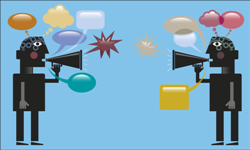This section introduces a variety of tools of analysis commonly used in linguistics. Each tool is commonly used by linguists to help understand how people present the world through language — how do we refer to the world around us?, how do we represent relationships between people and things?, how do we draw on our experience of one thing to describe another?
Each tool is introduced and illustrated with examples from everyday life, the media and conflict situations. The 'Spotting' boxes in each article also suggest where in everyday life you might be able to spot these interesting features of language! Recommended reading for each tool is also provided, guiding readers to both accessible and advanced sources where they can find out more.
An understanding of the tools in this section can enhance our understanding of language in conflict. Conflicts arise from people's differing conceptions of the world and how they think it ought to be, and it is through language that we express these views and enter into conflict about them. The tools gathered here help the analyst to describe how people present the world, and to understand how this can lead to conflict.





